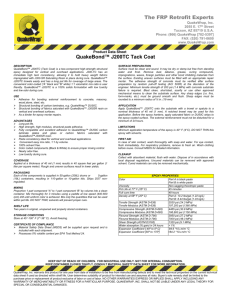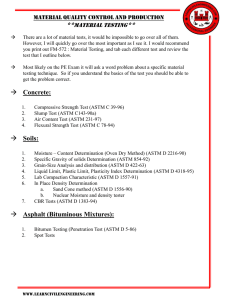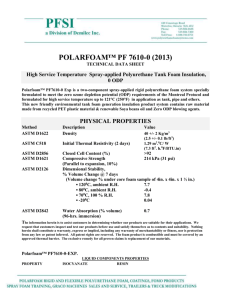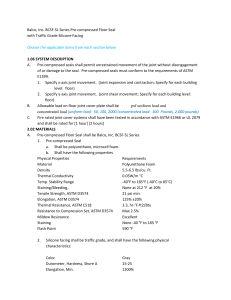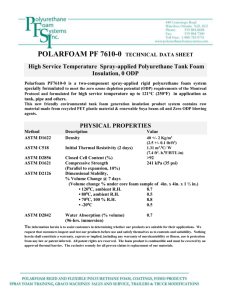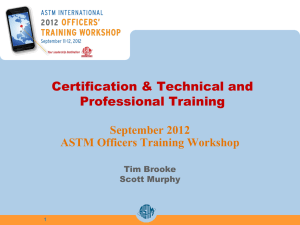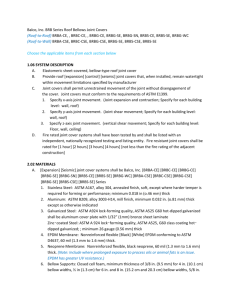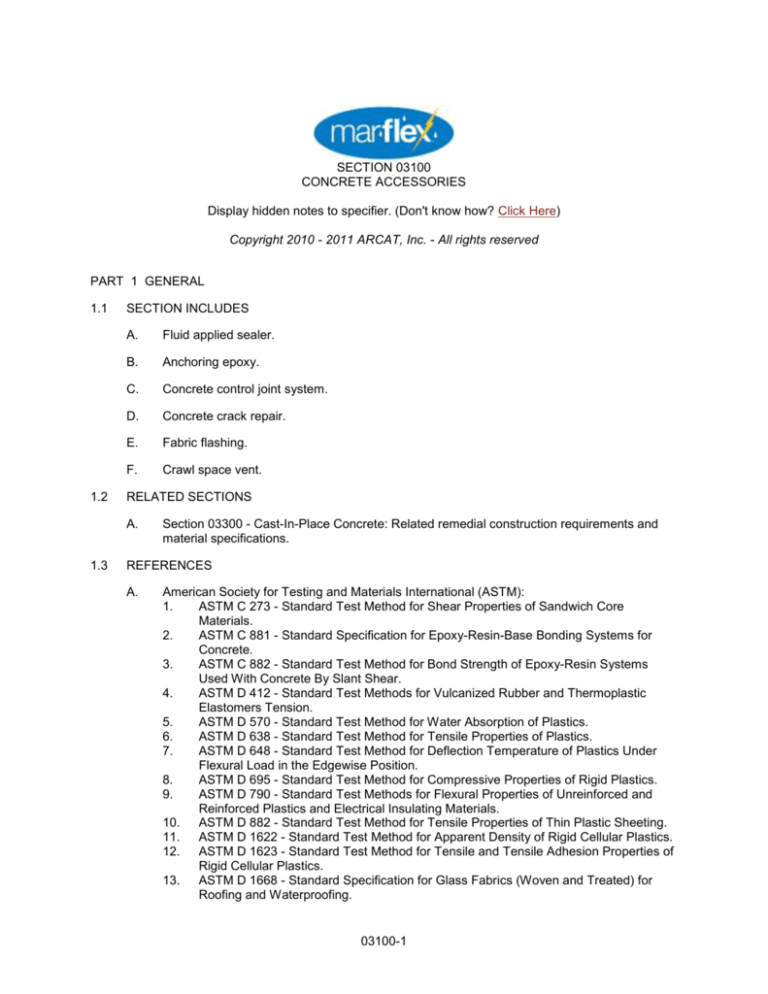
SECTION 03100
CONCRETE ACCESSORIES
Display hidden notes to specifier. (Don't know how? Click Here)
Copyright 2010 - 2011 ARCAT, Inc. - All rights reserved
PART 1 GENERAL
1.1
1.2
SECTION INCLUDES
A.
Fluid applied sealer.
B.
Anchoring epoxy.
C.
Concrete control joint system.
D.
Concrete crack repair.
E.
Fabric flashing.
F.
Crawl space vent.
RELATED SECTIONS
A.
1.3
Section 03300 - Cast-In-Place Concrete: Related remedial construction requirements and
material specifications.
REFERENCES
A.
American Society for Testing and Materials International (ASTM):
1.
ASTM C 273 - Standard Test Method for Shear Properties of Sandwich Core
Materials.
2.
ASTM C 881 - Standard Specification for Epoxy-Resin-Base Bonding Systems for
Concrete.
3.
ASTM C 882 - Standard Test Method for Bond Strength of Epoxy-Resin Systems
Used With Concrete By Slant Shear.
4.
ASTM D 412 - Standard Test Methods for Vulcanized Rubber and Thermoplastic
Elastomers Tension.
5.
ASTM D 570 - Standard Test Method for Water Absorption of Plastics.
6.
ASTM D 638 - Standard Test Method for Tensile Properties of Plastics.
7.
ASTM D 648 - Standard Test Method for Deflection Temperature of Plastics Under
Flexural Load in the Edgewise Position.
8.
ASTM D 695 - Standard Test Method for Compressive Properties of Rigid Plastics.
9.
ASTM D 790 - Standard Test Methods for Flexural Properties of Unreinforced and
Reinforced Plastics and Electrical Insulating Materials.
10.
ASTM D 882 - Standard Test Method for Tensile Properties of Thin Plastic Sheeting.
11.
ASTM D 1622 - Standard Test Method for Apparent Density of Rigid Cellular Plastics.
12.
ASTM D 1623 - Standard Test Method for Tensile and Tensile Adhesion Properties of
Rigid Cellular Plastics.
13.
ASTM D 1668 - Standard Specification for Glass Fabrics (Woven and Treated) for
Roofing and Waterproofing.
03100-1
14.
15.
16.
17.
18.
19.
20.
21.
B.
1.4
1.5
1.7
Federal Specifications (Fed. Spec.): Fed. Spec. HH-C-466b - Cloth, Glass, Coated.
SUBMITTALS
A.
Submit under provisions of Section 01300.
B.
Product Data: Manufacturer's data sheets on each product to be used, including:
1.
Preparation instructions and recommendations.
2.
Storage and handling requirements and recommendations.
3.
Installation methods.
C.
Selection Samples: For each finish product specified, two complete sets of color chips
representing manufacturer's full range of available colors and patterns.
D.
Verification Samples: For each finish product specified, two samples, minimum size 6 inches
(150 mm) square, representing actual product, color, and patterns.
QUALITY ASSURANCE
A.
1.6
ASTM D 2126 - Standard Test Method for Response of Rigid Cellular Plastics to
Thermal and Humid Aging.
ASTM D 2240 - Standard Test Method for Rubber Property Durometer Hardness.
ASTM D 3409 - Standard Test Method for Adhesion of Asphalt-Roof Cement to
Damp, Wet, or Underwater Surfaces.
ASTM D 3574 - Standard Test Methods for Flexible Cellular Materials Slab, Bonded,
and Molded Urethane Foams.
ASTM D 5451 - Standard Practice for Sampling Using a Trier Sampler.
ASTM D 4586 - Standard Specification for Asphalt Roof Cement, Asbestos-Free.
ASTM E 96 - Standard Test Methods for Water Vapor Transmission of Materials.
ASTM E 514 - Standard Test Method for Water Penetration and Leakage Through
Masonry.
Mock-Up: Provide a mock-up for evaluation of surface preparation techniques and
application workmanship.
1.
Finish areas designated by Architect.
2.
Do not proceed with remaining work until workmanship is approved by Architect.
3.
Refinish mock-up area as required to produce acceptable work.
DELIVERY, STORAGE, AND HANDLING
A.
Store products in manufacturer's unopened packaging until ready for installation.
B.
Store and dispose of solvent-based materials, and materials used with solvent-based
materials, in accordance with requirements of local authorities having jurisdiction.
PROJECT CONDITIONS
A.
Maintain environmental conditions (temperature, humidity, and ventilation) within limits
recommended by manufacturer for optimum results. Do not install products under
environmental conditions outside manufacturer's absolute limits.
PART 2 PRODUCTS
2.1
MANUFACTURERS
A.
Acceptable Manufacturer: Mar-Flex Waterproofing & Building Products, which is located at:
P. O. BOX 8256 500 Business Pkwy.; Carlisle, OH 45005; Toll Free Tel: 800-498-1411; Tel:
513-422-7285; Fax: 513-422-7282; Email:request info (info@mar-flex.com); Web:www.mar-
03100-2
flex.com
2.2
B.
Substitutions: Not permitted.
C.
Requests for substitutions will be considered in accordance with provisions of Section
01600.
SEALERS
A.
2.3
ANCHORING EPOXIES
A.
2.4
Siloxane Water Repellent:
1.
Product: Surfiseal Concrete and Brick Sealer as manufactured by Mar-flex
Waterproofing & Building Products.
2.
Material: Water-based emulsion siloxane water repellent.
3.
Color: Milky White dries to clear, transparent film.
4.
Total Solids: 7 to 10 percent Siloxane.
5.
Vapor Transmission: Excellent - No Moisture retained after 21 days.
6.
Application Method: Spray.
7.
Application Method: Brush.
8.
Application Method: Roll.
9.
Coverage Rate:
a.
Clay Brick: 100-150 sf/gal (2.45-3.68 m2/l).
b.
Cast in Place Concrete: 80-150 sf/gal (1.96-3.68 m2/l).
c.
Precast: 125-150 sf/gal (3.06-3.68 m2/l).
d.
Exposed Aggregate: 100-150 sf/gal (2.45-3.68 m2/l).
e.
Stucco: 100-150 sf/gal (2.45-3.68 m2/l).
f.
Rough Stone: 100-150 sf/gal (2.45-3.68 m2/l).
g.
Smooth Stone: 150-175 sf/gal (3.68-4.29 m2/l).
h.
Glazed Brick: 150-175 sf/gal (3.68-4.29 m2/l).
i.
Concrete Block: 60-90 sf/gal (1.47-2.20 m2/l).
10.
Drying Time: 1 to 2 hrs at 70 degree F (21 degree C).
11.
Full Chemical Reaction: 3 days.
12.
Freeze Point: 40 degree F (4 degree C).
13.
Water Penetration through Masonry (ASTM E 514): Average reduction in Leakage
Rate - 83 percent.
14.
N.C.H.R.P. Report 244 Series: 2; 77 percent reduction in chloride ion content.
Epoxy Adhesive:
1.
Product: Mar-flex Anchor Epoxy as manufactured by Mar-flex Waterproofing &
Building Products.
2.
Type: 100 percent solids moisture-insensitive, structural high strength, fast setting,
two component epoxy adhesive.
3.
Standard: ASTM C 881, Type I, II, IV and V, Grade 3, Class B and C.
4.
Material Characteristics:
a.
Mix Ratio: 1 part A to 1 part B by volume.
b.
Mixed Color: Gray.
c.
Consistency: non-sag gel.
d.
Gel Time: 6 to 8 minutes at 75 degree F (28 degree C).
e.
Cure: 90 percent of strength in 2 hours.
f.
Shelf Life: 2 years (unopened containers).
g.
Compressive Strength (ASTM D 695): 10,600 psi (73,084 kPa).
h.
Concrete Bonding (ASTM C 882): 3,000 psi (20,684 kPa) at 14 days.
i.
Water Absorption (ASTM D 570): 0.08 percent.
CONCRETE CONTROL JOINTS
03100-3
2.5
A.
Product: Mar-flex Control-Joint System as manufactured by Mar-flex Waterproofing &
Building Products.
B.
Control Joint Extrusion:
1.
Control Joint for 8 inch (203 mm) thick walls:
a.
3/4 inch by 2 inches by 4 foot (19 mm by 51 mm by 1219 mm).
b.
3/4 inch by 2 inches by 5 foot (19 mm by 51 mm by 1524 mm).
2.
Control Joint for 10 and 12 inch (254 mm and 305 mm) thick walls:
a.
1-1/4 inches by 2 inches by 4 foot (32 mm by 51 mm by 1219 mm).
b.
1-1/4 inches by 2 inches by 5 foot (32 mm by 51 mm by 1524 mm).
C.
Waterstop Filler: UV resistant rubber reinforced, asphalt base. Resistant to acids, alkalis and
salts in the soil and will not deteriorate.
1.
Standard: ASTM D 4586 Type I, ASTM D 1668, Fed. Spec. HH-C466b.
2.
Color: Black.
3.
Shore A Hardness (ASTM D 2240): 55.
4.
Elongation (ASTM D 412): 500 percent.
5.
Tensile Strength (ASTM D 412): 400 psi (2758 kPa).
6.
Water Vapor Performance (ASTM E 96): 0.017 perm.
7.
Water Absorption: 0.07.
D.
Waterstop Fabric:
1.
Material: Fabric composed of highly flexible woven fiberglass yarn.
2.
Standard: ASTM D 3409, ASTM D 1668, Fed. Spec. HH-C466b.
3.
Tensile Strength:
a.
Warp (lbs/lineal inch): 75.
b.
Fill (lbs/lineal inch): 75.
CRACK REPAIR
A.
Design: Crack Stitching Method:
B.
Mar-flex Staple Kit:
1.
Material: Toughened High-Mod Gel.
2.
Carbon Fiber Staples.
a.
1 inch by 12 inches by 1 inch by 1 inch (25 mm by 305 mm by 25 mm by 25
mm).
3.
Application:
a.
Drying and Shrinkage Crack Repair: Provide epoxy or urethane injection.
Provide Stitching along the repair material glue line.
b.
Structural Cracks: Cracks that are larger than 3/8 inch (9.5 mm) may require a
gel epoxy rather than a low viscosity epoxy.
c.
Aligning the carbon tows at 30 degrees to the expected shear loads will load
the carbon in tension, allowing carbon to function in shear.
d.
Formulated to meet ASTM C 881.
e.
Mix Ration: 1:1.
f.
Color: Green.
g.
Full Cure: Allow a minimum of 8-24 hours depending on temperature, for a full
cure before loading.
h.
Shelf Life: 1 year (unopened)
C.
Epoxy Injection:
1.
Low Viscosity Epoxy Crack Filler Paste as manufactured by Mar-flex Waterproofing &
Building Products.
a.
Material: Moisture insensitive epoxy with a 200 cps.
b.
Application: Designed for the injection of wet or dry cracks that need a
structural repair and that are hairline or larger. It can be used to inject floor
03100-4
c.
d.
e.
f.
g.
h.
i.
j.
k.
l.
m.
n.
o.
p.
q.
D.
cracks.
Formulated to meet ASTM C 881.
Physical properties after a 14-day cure, 75 degree F (24 degrees C).
Mix Ratio: 2:1.
Mixed Color: Gray.
Consistency: Paste.
Initial Cure: 1 to 3 hours.
Full Cure: 1 to 2 days.
Shelf Life: 1 yr (unopened).
Compressive Strength (ASTM D 695): 12,000 psi (82,737 kPa).
Compressive Modules (ASTM D 695) (28 days): 500,000 psi (3,447,379 kPa).
Concrete Bonding (ASTM C 882): 2,800 psi (19,305 kPa).
Tensile Strength (ASTM D 638): 8,500 psi (58,605 kPa).
Tensile Elongation (ASTM D 638 modified): 2-4 percent.
Shear Strength (ASTM D 732): 5,100 psi (35,163 kPa).
Deflection Temperature (ASTM D 648): 126 degree F (52 degree C).
Urethane Injection:
1.
Product: Quick Foam Fine Urethane as manufactured by Mar-flex Waterproofing &
Building Products.
a.
Material: Hydrophobic polyurethane liquid with a 600 cps.
b.
Application: Designed to stop water infiltration or ex-filtration through cracks
that, once introduced to water, reacts forming a closed cell barrier that prevents
water infiltration.
c.
Mix Ratio: 1:1.
d.
Mixed Color: Amber.
e.
Consistency: Paste.
f.
Initial Cure: 20 minutes.
g.
Full Cure: 24 hours.
h.
Shelf Life: 1 yr (unopened).
i.
Density (Core) (ASTM D 1622 - Free Rise): 2.02 lbs.ft. (279 kg.mm).
j.
Shrinkage - Low Temp (ASTM D 2126): (1 day - < 0 percent), (7 days - < 0
percent).
k.
Water Absorption (ASTM D 2127): < 1 percent.
l.
Shear Strength (ASTM C 273): 34 psi (234 kPa).
m.
Tensile Strength (ASTM D 1623): 31psi (214 kPa).
n.
Elongation (ASTM D 1623): 45 percent.
o.
TDI Content: 0 percent.
p.
Solids: 100 percent.
2.
Product: Quick Foam Broad as manufactured by Mar-flex Waterproofing & Building
Products.
a.
Material: Hydrophilic polyurethane liquid with a 100 cps.
b.
Application: Designed to be injected into cracks to stop water infiltration and ex
-filtration. When the product reacts it creates a closed cell barrier that prevents
water infiltration. Best suited for cracks that are 1/8 inch (3 mm) or wider which
are wet or actively leaking.
c.
Mix Ratio: 1:1(With added water on one side).
d.
Mixed Color: Amber.
e.
Consistency: Paste.
f.
Initial Cure: 1 minute.
g.
Full Cure: 24 hours.
h.
Shelf Life: 1 yr (unopened).
i.
Tensile Strength (ASTM D 3574): 380 psi (2620 kPa).
j.
Tensile Elongation (ASTM D 3574): 400 percent.
k.
Bonding Strength: 150 to 300psi (1034 to 2068 kPa).
l.
Shrinkage: < 5 percent.
03100-5
m.
E.
2.6
Flash Point (of uncured product): 225 degree F (107 degree C).
Paste Adhesive:
1.
Product: Quick Set Surface Seal and Peel as manufactured by Mar-flex Waterproofing
& Building Products.
a.
Material: Two component, solvent free polyurea paste adhesive.
b.
Mixed Color: Gray.
c.
Consistency: Paste.
d.
Pot Life:
1)
100 G at 40 degree F (4 degree C) = 9 minutes.
2)
100 G at 72 degree F (22 degree C) = 4 minutes.
e.
Full Cure: 30-45 minutes.
f.
Shelf Life: 1 Year. (unopened).
g.
Time to Bond (ASTM D 5451):
1)
at 40 degree F (4 degree C) for 90 minutes - > 200 psi (1379 kPa).
2)
at 72 degree F (22 degree C) (22 degree C) for 30 minutes - > 200 psi
(1379 kPa).
h.
Bond strength development at 72 degree F (22 degree C):
1)
Cure time - 30 minutes - 200 psi (1379 kPa).
2)
Cure time - 60 minutes - 350 psi (2413 kPa).
3)
Cure time - 90 minutes - 400 psi (2758 kPa).
2.
Product: Quick Set Surface Port Paste as manufactured by Mar-flex Waterproofing &
Building Products.
a.
Material: Two component smooth epoxy adhesive.
b.
Mix Ratio: 1:1.
c.
Mixed Color: Gray.
d.
Consistency: Paste.
e.
Pot Life: 6-10 minutes.
f.
Full Cure:
1)
at 40 degree F (4 degree C) - 1.5 to 1.75 hours.
2)
at 73 degree F (23 degree C) - 25 to 30 minutes.
3)
at 90 degree F (32 degree C) - 20 to 25 minutes.
g.
Shelf Life: 2 Year. (unopened).
h.
Compressive Strength at 40 degree F (4 degree C):
1)
Cure time - 1 hr. - 30 psi (207 kPa).
2)
Cure time - 4 hr. - 3,500 psi (24,132 kPa).
3)
Cure time - 16 hrs. - 6,900 psi (47,574 kPa).
4)
Cure time - 7 days - 8,300 psi (57,226 kPa).
i.
Compressive Strength at 73 degree F (23 degree C):
1)
Cure time - 1 hr. - 5,600 psi (38,611 kPa).
2)
Cure time - 4 hr. - 7,800 psi (53,779 kPa).
3)
Cure time - 16 hrs. - 8,500 psi (58605 kPa).
4)
Cure time - 7 days - 9,200 psi (63,432 kPa).
j.
Bond Strength (ASTM C 882): 2 day dry cure - 3,000 psi (20,684 kPa).
k.
Tensile Strength (ASTM D 638): 1 day - 3,3000 psi (22,753 kPa).
l.
Flexural Properties (ASTM D 790): 1 day - 5,000 psi (34,474 kPa).
m.
Shear Properties (ASTM D 7362): 1 day - 2,500 psi (17,237 kPa).
n.
Deflection Temperature (ASTM D 648) - 1 day: 115 degree F (46 degree C).
o.
Water Absorption (ASTM D 570) - 7 days - 2 hour boil: 0.8 percent.
FABRIC FLASHING
A.
A self-adhering, cold applied composite sheet membrane comprised of 36 mils (0.9 mm) of
rubberized asphalt integrally bonded to a 4 mil (0.1 mm) film of high density cross-laminated
polyethylene for a minimum thickness of 40 mils (1.0 mm). The strips are available in 4
inches, 6 inches, 12 inches, 18 inches and 24 inches (51 mm, 152 mm, 305 mm, 457 mm,
03100-6
and 610 mm) widths.
1.
Product: EcoFlash Flashing as manufactured by Mar-flex Waterproofing & Building
Products.
a.
Puncture Resistance - Film (ASTM D 781): 95 lbs/inch (110 kg/cm).
b.
Puncture Resistance of Composite Membrane (ASTM E 154): 40 minimum.
c.
Elongation of Rubberized Asphalt (ASTM D 882-modified): 400 percent
minimum.
d.
Tensile Strength of Composite (ASTM D 412-modified): 750 psi (5171 kPa)
minimum.
e.
Water Vapor Transmission (Permeance) (ASTM E 96 method B): 0.05
Grains/sf/hr in HG maximum.
f.
Total Thickness: 40 mils (1 mm).
g.
Color: White.
2.
Primer: As recommended by flashing manufacturer.
3.
Mastic: All Season Asphalt 362 Mastic as manufactured by Mar-flex Waterproofing &
Building Products.
2.7
2.8
CRAWL SPACE VENTS
A.
Design requirements: International Residential (2006) - Openings for Under-Floor Ventilation
(R408.2):
1.
R408.2: The minimum net area of ventilation openings shall not be less than 1 square
foot (0.0929 m2) for each 150 square feet (14 m2) of under-floor area. One ventilating
opening shall be within 3 feet (914 mm) of each corner of the building. Ventilation
openings shall be covered for their height and width with any of the following materials
provided that the least dimension of the covering openings shall not exceed 1/4 inch
(6.4 mm):
a.
Perforated sheet metal plates not less than 0.070 inch (1.8 mm) thick.
b.
Expanded sheet metal plates not less than 0.047 inch (1.2 mm) thick.
c.
Cast-iron grill or grating.
d.
Extruded load-bearing brick vents.
e.
Hardware cloth of 0.035 inch (0.89 mm) wire or heavier.
f.
Corrosion-resistant wire mesh, with the least dimension being 1/8 inch (3.2
mm).
B.
Telescopic, Variable Flow Control Foundation and Crawl Space Vents:
1.
Product: Vortex as manufactured by Mar-flex Waterproofing & Building Products.
a.
Construction: High-density polyethylene material.
2.
Vortex Thin Manual BCV-80050 Vent: Allows user to adjust airflow using easy-toaccess controls.
a.
Adjusts from 4.75 to 7 inches (120 mm to 178 mm) and fits 5, 6 and 7 inches
(127 mm, 152 mm and 178 mm) walls, nominal or full size.
b.
Dimension: 19-1/4 inches W by 11-1/4 inches H (489 mm by 286 mm).
c.
Clear Vent Area (CVA) 31.4 sq. inches (20,258 sq. mm).
d.
Screen included.
3.
Vortex Manual BCV-80150: Vent features easy-to-access controls that allow user to
adjust airflow.
a.
Adjusts from 7.5 to 10 inches (191 mm to 254 mm) and fits 8, 9 and 10 inch
walls, (203 mm, mm, 254 mm) nominal or full size.
b.
Dimension: 19-1/4 inches W by 11-1/4 inches H (489 mm by 286 mm).
c.
Clear Vent Area (CVA) 31.4 sq. inches (20,258 sq. mm).
d.
Screen included.
ACCESSORY MATERlALS
A.
Mastic:
1.
Product: All Season Asphalt 362 Mastic as manufactured by Mar-flex Waterproofing &
03100-7
2.
3.
4.
5.
Building Products.
Color: Black.
Consistency: Rubber coating.
ASTM D 4586 Type I.
ASTM D 3409.
B.
Injection Ports: Provide ports as manufactured by Mar-flex Waterproofing & Building
Products.
1.
Low-Pressure Drill In Port.
2.
Universal Surface/Corner Mounts.
C.
Quick Set Urethane Adhesive as manufactured by Mar-flex Waterproofing & Building
Products.
1.
Material: Polyurethane Prepolymer Adhesive.
2.
Mix Ratio: 1:1.
3.
Mixed Color: White.
4.
Consistency: Paste.
5.
Initial Cure: 3 to 5 minutes.
6.
Injection time: 10 to 20 minutes.
7.
Viscosity: 15,000 cps.
PART 3 EXECUTION
3.1
3.2
3.3
EXAMINATION
A.
Do not begin installation until substrates have been properly prepared.
B.
If substrate preparation is the responsibility of another installer, notify Architect of
unsatisfactory preparation before proceeding.
PREPARATION
A.
Clean surfaces thoroughly prior to installation.
B.
Prepare surfaces using the methods recommended by the manufacturer for achieving the
best result for the substrate under the project conditions.
CRACK REPAIR
A.
Mar-flex Staple Kit Installation:
1.
Crack Injection must be performed prior to applying the staples.
a.
Allow for full cure of injection product before stapling.
2.
Laying out the job/Preparing the wall:
a.
Measure the length of cracks and divide into 24 inch (610 mm) segments. Note:
There must be no more than 24 inches (610 mm) between segments.
b.
Mark locations making sure there are no obstructions that would interfere with
the planned staple locations.
c.
Hold staple over the determined location at the appropriate angle and mark.
See Design Guide to determine the correct orientation of each staple according
to angle and nature of the crack.
d.
Using a 1 inch (25 mm) diameter masonry drill, make a hole 1 inch (25 mm)
deep at each mark.
e.
Using a 3 inch (76 mm) chisel, prepare the concrete surface around the holes
and where the stitch will attach. For proper adhesion, the wall surface within
this space must be free of paint and as smooth as possible.
3.
Application of the Staple:
a.
Load the double-cylinder epoxy cartridge into the dual applicator and "burp" the
03100-8
b.
c.
d.
e.
f.
g.
B.
3.4
cartridge so that an even flow of material exits both cylinders.
Attach the static mixing nozzle.
Fill two holes and apply a coat of epoxy between them in the area under the
staple to be installed. Put as much adhesive as needed to make a smooth, flat
layer 1/8 inch (3 mm) thick.
Position staple over the two holes.
Push the staple into the epoxy until it touches the wall. Press the material to
force the epoxy completely up through the grids of the staple.
Trowel epoxy evenly over the staple. Ensure that epoxy penetrates the grid and
covers the staple completely.
Use a trowel to push epoxy to fill gaps and unfilled spaces. Staples must be
completely covered with epoxy when finished.
Injection:
1.
Installing Universal Surface/Corner Mounts and Low-Pressure Drill-In Ports:
a.
Lay down crack injection drop cloth and wire brush the surface area to remove
debris and roughen the surface.
b.
Place a paste cartridge in the injection gun and remove end caps. Inject just
enough into a stir dish to attach ports. Mix well with a putty knife or tongue
depressor.
c.
Apply surface paste adhesive to the base of each Universal Surface/Corner
Port, being sure not to cover the injection hole with the paste.
d.
Starting at the bottom of the crack, place ports every 8 to 10 inches (203 to 254
mm) apart over crack until reaching the top.
2.
Installing Low-Pressure Drill-In Ports:
a.
Use a 5/8 inch (16 mm) concrete drill bit to drill a 2 inches to 4 inches (51 mm
to 102 mm) deep hole at a 15 to 30 degree angle intersecting the crack. You
will feel a slight release of pressure when your drill bit intersects the crack.
b.
Repeat ever 8 inches to 10 inches (203 mm to 254 mm) alternating from side to
side until entire crack is drilled. Use a can of compressed air to remove
concrete dust from drilled holes.
c.
Insert the black-sleeved end into the drilled hole. No other parts are needed.
3.
Surface Paste Application:
a.
Feather paste out a minimum of 2 inches (51 mm) wide over the crack and
build up 1/4 inch (6 mm) around each port. Allow paste to cure. To accelerate
curing a heat gun may be used. Do not begin injection until surface of paste
resists a putty knife impression.
4.
Injection:
a.
Begin injection at the lowest port, injecting with slow consistency until product
begins to flow from the port above. Begin injecting the next port and so on up
the crack. Keep injection gun parallel to the port during the process.
1)
If fluid stops flowing through the static mixer and pressure increases on
the trigger, this could be a sign of dust clogging up the flow of product in
the crack. At this time, relieve pressure off gun, cap off port and move to
next port.
2)
If a "blow out" during injection occurs, inject the area with Quick Set
Urethane Adhesive.
b.
Allow product to set up for a minimum of 24 hours.
c.
If removal of the ports and paste is required, use a chisel and a hammer to port
and paste. A grinder/sander may be used.
CONCRETE CONTROL JOINT INSTALLATION
A.
After the control joint extrusions are placed, reinforcing bars (4 each #4) shall cross the joint
and extend a minimum of 4 feet (1219 mm) each side. This will prevent the control joint from
opening in a vertical line, to maintain aggregate interlock in the crack and structural integrity
03100-9
of the wall.
3.5
3.6
B.
After concrete placemen and initial cure, carefully remove the reusable control joint
extrusions with the foundation wall forms.
C.
Wire-brush the surface area of the control joint before applying sealant to rid surface of dirt,
dust, form oil, grease or any other foreign material.
D.
With a conventional caulk gun or trowel, apply sealant into the exterior of the control joint
from the top of the footing up to the grade line. Fill joint until it is flush with the surface of the
wall and then feather out onto both sides 2 inches (51 mm). Dry tool with light pressure
immediately after applying.
E.
Press the fiberglass reinforcement fabric into the sealant before curing occurs. Apply fabric
on the exterior of the control joint from the top of the footing to the grade line.
SEALER INSTALLATION
A.
Install in accordance with manufacturer's instructions.
1.
Agitate sealer before application.
2.
Do not dilute sealer.
B.
For vertical application:
1.
Application Method: Spray.
a.
Apply a single application of sealer with low pressure spray equipment (15 psi
or .1 MPa).
b.
Use a fan spray nozzle for greatest efficiency.
2.
Application Method: Broom.
3.
Application Method: Roll.
4.
Apply material from the bottom of the wall upwards so that it will run down the surface
at least 6 inches (152 mm) below the spray pattern.
5.
For porous vertical substrates or for maximum protection, apply two "wet-on-wet"
applications of sealer.
C.
Horizontal Application
1.
Application Method: Spray.
2.
Application Method: Broom.
3.
Application Method: Roll.
4.
Material shall be sufficiently applied to completely flood the surface; approximately
125 sf/gal (3 m2/l) depending on the porosity of the surface.
5.
Typically the surface can be re-opened to traffic in 1 to 2 hours, if the temperature is
72 degree F (22 degree C) or above.
6.
Full chemical reaction will take 3 days.
ADHESIVE ANCHOR INSTALLATION
A.
Install in accordance with manufacturer's instructions.
B.
For anchoring of bolts, dowels, rebar etc. the depth of the hole shall be approximately 9 to
15 times the bolt diameter. The whole space around the bolt in the hole shall not exceed 1/8
inch (3 mm).
C.
Drilled holes should be cleaned with a bristle brush. Remove all water and dust with clean
compressed air prior to installation. Air and surface temperature must be 40 degrees F (4
degree C) or above.
D.
Dispense into anchoring hole filling from the bottom up until full.
03100-10
E.
3.7
3.8
Insert the bolt, dowel or anchor turning it slowly during insertion. After insertion, the hole
shall be completely full of epoxy.
FABRIC FLASHING INSTALLATION
A.
Surface Preparation:
1.
Ensure that all surfaces are dry, smooth and regular, free from defects and excessive
dust.
2.
Concrete surfaces shall be smooth and without large voids, spalled areas or sharp
protrusions. Concrete shall be cured a minimum of 14 days and shall be dry before
transition strip is applied.
3.
Prime surfaces to receive fabric flashing using the primer. Apply primer with a roller,
brush or spray equipment at a rate of 100 to 300 sf/gallon (2.45 to 7.35 sq. m/l)
depending on porosity and texture of the surface. Allow primer to dry prior to fabric
flashing installation.
B.
Application:
1.
Overlap fabric flashing a minimum of 2 inches (51 mm) onto both surfaces. When
properly aligned, roll back and remove protective film. Place transition strip against
surface by pressing firmly with a hand roller. When using the transition strip with brick
ties, position strip, press in place and then cut for ties and protrusions. Seal around
openings and exposed edges with the mastic.
2.
Fabric flashing is not designed to perform as a permanently exposed flashing. Limit
exposure to approximately six weeks.
PROTECTION
A.
Protect installed products until completion of project.
B.
Touch-up, repair or replace damaged products before Substantial Completion.
END OF SECTION
03100-11

